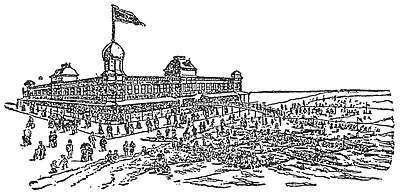William Wainwright (land developer)
William Wainwright (1836, Philadelphia, Pennsylvania – August 14, 1904, Brooklyn, New York)[1] was a real-estate developer who was largely responsible in the late 19th and early 20th centuries for the transformation of Rockaway Beach, New York City, into a major resort and amusement area.
William Wainwright | |
|---|---|
| Born | 1836 Philadelphia, Pennsylvania, U.S. |
| Died | August 14, 1904 |
Biography

Wainwright was born in Philadelphia in 1836.[2] At the age of 15, he moved to New York in order to find work. He worked in the mailing room of The New York Times for a few years.[2] Afterwards, Wainwright founded the Brooklyn News Agency.[2] After building up the business, he sold the Brooklyn News Agency to the American News Agency and moved to the City of Williamsburg in Brooklyn.[2] He opened a billiard hall on Grand Street.[2] After adding a restaurant to the establishment, it became a well-known oyster house.[2]
Wainwright was elected to the New York State Assembly in 1870.[2] He declined to run for reelection, preferring to focus on his business interests.[2]
Wainwright opened the Odeon Theatre in Williamsburg, which also had a billiard room and restaurant on site.[2]
After selling the Odeon Theatre, Wainwright became the owner of the Lake House in Lake Hopatcong, New Jersey.[2] He subsequently sold the Lake House and bought the Pavilion, which was at the time the largest hotel in Islip, Long Island.[2]
In 1875, Wainwright sold all of his businesses in order to buy half the interest in 150 acres (61 ha) of land in Rockaway Beach for $15,000.[2] With his partner James Remsen, the firm of Remsen & Wainwright began developing Rockaway Beach.[2] The firm built the Seaside House, which was then the largest hotel on the coast.[2] He continued to manage and expand the hotel after Remsen's death in 1887.[2] After Wainwright took another partner, the name Wainwright & Smith became ubiquitous on different amusement pavilions in Rockaway Beach.[2] A fire of unknown cause burned eight blocks of Rockaway Beach, including the Seaside House on September 21, 1892.[3] Wainwright rebuilt the Seaside House even larger than before.[3]
Wainwright retired from actively managing his business in 1901 due to his poor health.[2] His son J. W. Wainwright took over the management for him.[2]
On June 1, 1902, a fire started in the rear of Kasten's Hotel in Rockaway Beach.[4] The fire spread and ended up killing four people, injuring four other people, and destroying many of the properties owned by Wainwright.[4] Wainwright was determined to rebuild.[4]
Wainwright died in his home at 842 Union Street in Park Slope, Brooklyn, on August 14, 1904.[2] The cause of death was an attack of gastritis.[2]
Sources
- William Wainwright at Find a Grave
- "William Wainwright Dead: Much of the Development of Rockaway Beach Due to Him]". The New York Times. August 15, 1904. p. 7.
- "To Rebuild at Rockaway Beach: The Police Scout the Theory of Incendiarism". The New York Times. September 22, 1892. p. 2.
- "Four Perish in Fire at Rockaway Beach: Two Blocks, Comprising Museum, Casino, and Hotels, Destroyed: Several Persons Injured: Heat So Great Firemen Had to Use Doors as Shields: Policeman Threatened People to Save Them: Loss, $125,000". The New York Times. June 2, 1902. p. 1.
- Vincent F. Seyfried, The Long Island Rail Road: A Comprehensive History, Part Five, published by the author, Garden City, Long Island, 1966.
- Vincent F. Seyfried and William Asadorian, Old Rockaway, New York, in Early Photographs, Dover Publications, 2000.